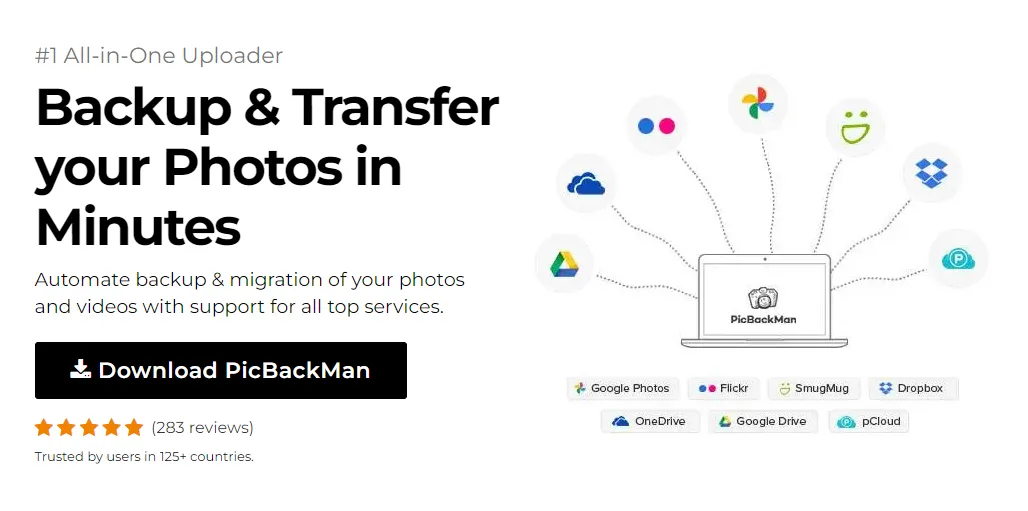
Why is it the #1 bulk uploader?
- Insanely fast!
- Maintains folder structure.
- 100% automated upload.
- Supports RAW files.
- Privacy default.
How can you get started?
Download PicBackMan and start free, then upgrade to annual or lifetime plan as per your needs. Join 100,000+ users who trust PicBackMan for keeping their precious memories safe in multiple online accounts.
“Your pictures are scattered. PicBackMan helps you bring order to your digital memories.”
[Step-by-Step Guide] How to Add iCloud Email to Outlook


Adding your iCloud email to Microsoft Outlook helps you manage all your emails in one place. This guide walks you through the exact steps to connect your Apple iCloud email account with Outlook, whether you're using the desktop application or the web version. I'll cover everything from finding the right settings to troubleshooting common problems.
Why Connect iCloud Email to Outlook?
Before jumping into the steps, let's quickly look at why you might want to add your iCloud email to Outlook:
- Manage multiple email accounts in one place
- Take advantage of Outlook's organization features
- Access your iCloud emails offline
- Use Outlook's powerful search and filtering tools
- Keep your work and personal emails separate but accessible
Requirements Before You Start
Make sure you have these things ready before beginning:
- Your iCloud email address and password
- Microsoft Outlook installed on your device (or access to Outlook.com)
- An app-specific password for iCloud (I'll show you how to get this)
- Active internet connection
Getting an App-Specific Password for iCloud
Apple uses two-factor authentication for security. This means you'll need to create an app-specific password for Outlook to access your iCloud account.
How to Generate an App-Specific Password:
- Go to appleid.apple.com and sign in with your Apple ID
- Navigate to the "Security" section
- Click on “Generate Password” under the “App-Specific Passwords” section
- Enter a name for the password (like "Outlook")
- Click "Create"
- Apple will display your app-specific password - copy it down as you'll need it when setting up Outlook
Adding iCloud Email to Outlook Desktop App
Let's start with the process for the Outlook desktop application, which works for Outlook 2016, 2019, 2021, and Microsoft 365 versions.
Method 1: Using Automatic Setup
- Open Outlook on your computer
- Click on "File" in the top menu
- Select "Add Account" or "Info" > "Add Account"
- Enter your iCloud email address
- Click "Connect" or "Next"
- When prompted for a password, enter the app-specific password you generated (not your regular iCloud password)
- Click "Connect" or "Next" to proceed
- Outlook will attempt to configure your account automatically
- If successful, click "Finish" to complete the setup
Method 2: Manual Setup (If Automatic Setup Fails)
Sometimes the automatic setup doesn't work properly. Here's how to set up your iCloud email manually:
- Open Outlook and go to "File" > "Add Account"
- Enter your iCloud email address
- Click "Advanced options" and check "Let me set up my account manually"
- Click "Connect"
- Select "IMAP" as the account type
- Fill in the following information:
Incoming Mail Server Settings:
- Server: imap.mail.me.com
- Port: 993
- Encryption method: SSL/TLS
Outgoing Mail Server Settings:
- Server: smtp.mail.me.com
- Port: 587
- Encryption method: STARTTLS
- Click "Next"
- Enter your app-specific password when prompted
- Click "Connect"
- After Outlook tests the settings, click "Done" to finish
Adding iCloud Email to Outlook.com or Outlook Web App
If you prefer using Outlook in your web browser, here's how to add your iCloud account:
- Go to Outlook.com and sign in
- Click on the gear icon (Settings) in the top-right corner
- Select "View all Outlook settings" at the bottom of the menu
- Click on "Mail" in the left panel
- Select "Sync email"
- Click "Add email account"
- Enter your iCloud email address and click "Next"
- You'll be prompted to sign in to your iCloud account
- Enter your app-specific password (not your regular iCloud password)
- Click "Sign in"
Adding iCloud to Outlook on Mobile Devices
For Outlook on iOS:
- Open the Outlook app on your iPhone or iPad
- Tap on your profile icon in the top-left corner
- Tap the gear icon (Settings)
- Select "Add Account"
- Choose "Add Email Account"
- Enter your iCloud email address
- Tap "Continue" and select "IMAP"
- Enter your app-specific password
- Fill in the server information as listed in the setup manual section above
- Tap "Sign In"
For Outlook on Android:
- Open the Outlook app on your Android device
- Tap on your profile icon in the top-left corner
- Tap the gear icon (Settings)
- Select "Add Account"
- Enter your iCloud email address
- Tap "Continue"
- Choose "IMAP account" when prompted
- Enter your app-specific password
- Enter the server settings as detailed in the manual setup section
- Tap "Sign In"
Detailed iCloud Server Settings for Outlook
For reference, here's a complete table of the server settings you'll need:
| Setting Type | Server Address | Port | Encryption |
|---|---|---|---|
| Incoming (IMAP) | imap.mail.me.com | 993 | SSL/TLS |
| Outgoing (SMTP) | smtp.mail.me.com | 587 | STARTTLS |
Quick Tip to ensure your videos never go missing
Videos are precious memories and all of us never want to lose them to hard disk crashes or missing drives. PicBackMan is the easiest and simplest way to keep your videos safely backed up in one or more online accounts.
Simply download PicBackMan (it's free!) , register your account, connect to your online store and tell PicBackMan where your videos are - PicBackMan does the rest, automatically. It bulk uploads all videos and keeps looking for new ones and uploads those too. You don't have to ever touch it.
Verifying Your iCloud Email Setup in Outlook
After adding your iCloud email to Outlook, it's important to verify that everything is working correctly:
- Check that your iCloud email appears in the folder list on the left side of Outlook
- Send a test email to yourself
- Check that you can receive emails to your iCloud address
- Make sure your sent items are properly saved in the Sent folder
Customizing Your iCloud Email Experience in Outlook
Now that your iCloud email is set up in Outlook, you might want to customize how it works:
Setting a Default Send-From Address
- Go to "File" > "Options" in Outlook desktop
- Select "Mail" from the left menu
- Under "Send messages," click "Accounts"
- Select the account you want to use as default
- Click "Set as Default"
- Click "Close" and "OK" to save changes
Creating Email Signatures for Your iCloud Account
- Go to "File" > "Options" in Outlook desktop
- Select "Mail" from the left menu
- Click "Signatures"
- Click "New" to create a signature
- Name your signature
- Design your signature in the editing box
- Under “Choose default signature,” select your iCloud email account
- Choose your signature for new messages and replies/forwards
- Click "OK" to save
Setting Up Folders and Rules
Organize your iCloud emails in Outlook with folders and rules:
- Right-click on your iCloud account in the folder pane
- Select "New Folder" and name it
- To create rules, go to “Home” > “Rules” > “Create Rule”
- Set conditions for when emails arrive
- Choose actions like moving to specific folders
- Click "OK" to save the rule
Troubleshooting Common Issues
Sometimes things don't go as planned. Here are solutions to common problems:
Can't Connect to iCloud Email
- Double-check that you're using the app-specific password, not your regular iCloud password
- Verify that your internet connection is working
- Check that your iCloud email account is active by logging in at icloud.com
- Make sure you've entered the correct server settings
Emails Not Syncing
- Check your internet connection
- In Outlook, right-click your iCloud account and select “Update Folder”
- Check if you have folder sync limits set:
- Go to "Account Settings" > "Account Settings"
- Double-click your iCloud account
- Click "More Settings" > "Advanced"
- Make sure "Download entire message" is selected
Sending Emails Fails
- Verify your outgoing server settings
- Check if your internet service provider blocks port 587
- Try regenerating a new app-specific password
- Make sure your iCloud account doesn't have any restrictions
Authentication Errors
If you keep getting authentication errors:
- Generate a new app-specific password from your Apple ID account page
- Update the password in Outlook:
- Go to "File" > "Account Settings" > "Account Settings"
- Select your iCloud account and click "Change"
- Enter your new app-specific password
- Click "Next" and then "Close"
Comparison: iCloud in Outlook vs. Apple Mail
| Feature | iCloud in Outlook | Apple Mail |
|---|---|---|
| Cross-platform availability | Windows, Mac, iOS, Android, Web | Mac and iOS only |
| Integration with calendar | Good with some limitations | Excellent native integration |
| Contact syncing | Limited | Full native support |
| Email organization tools | Excellent (rules, categories, etc.) | Good but more basic |
| Search capabilities | Very powerful | Good but less advanced |
Managing Multiple Email Accounts in Outlook
One of the biggest advantages of adding your iCloud email to Outlook is managing multiple accounts in one place. Here are some tips:
Creating a Unified Inbox
- In Outlook desktop, look for "All Accounts" or "All Unread" in the folder pane
- This shows emails from all your accounts connected together
- You can still view individual accounts separately when needed
Color-Coding Your Accounts
- Right-click on your iCloud account in the folder pane
- Select "Color Categories" or "Color"
- Choose a distinct color for your iCloud emails
- This helps you quickly identify which account emails belong to
Setting Account-Specific Check Frequencies
- Go to "File" > "Account Settings" > "Account Settings"
- Select your iCloud account and click "Change"
- Click "More Settings" > "Advanced"
- Adjust the "Server Timeouts" and "Delivery" settings
- Click "OK" and then "Next" > "Finish"
Syncing iCloud Contacts and Calendar with Outlook
While adding your iCloud email to Outlook doesn't automatically sync your contacts and calendar, you can set this up separately:
Syncing iCloud Contacts
- Download and install iCloud for Windows from Apple's website
- Open iCloud for Windows and sign in with your Apple ID
- Check the box next to "Mail, Contacts, Calendars, and Tasks with Outlook"
- Click "Apply"
- Your iCloud contacts will now sync with Outlook
Syncing iCloud Calendar
- With iCloud for Windows installed and configured as above
- Your calendars will automatically sync
- In Outlook, go to the Calendar view to see your iCloud calendars
Backing Up Your iCloud Emails in Outlook
An added benefit of having your iCloud emails in Outlook is the ability to back them up:
- Go to "File" > "Open & Export" > "Import/Export"
- Select "Export to a file" and click "Next"
- Choose "Outlook Data File (.pst)" and click "Next"
- Select your iCloud email folder and make sure “Include subfolders” is checked
- Click "Next"
- Choose a location to save the file and set any options
- Click "Finish"
- If prompted for a password, you can set one or leave it blank
Security Considerations
When adding your iCloud email to Outlook, keep these security points in mind:
- Using an app-specific password is more secure than your main password
- Outlook stores your email credentials, so keep your device secure
- If you lose your device, revoke the app-specific password from your Apple ID account page
- Consider enabling two-factor authentication for both your Apple ID and Microsoft account
- Regularly update both Outlook and your operating system
Conclusion
Adding your iCloud email to Outlook is a straightforward process that gives you the best of both worlds—Apple's reliable email service with Microsoft's powerful organization tools. By following the steps in this guide, you can easily set up your iCloud email in Outlook on desktop, web, or mobile devices.
Remember to generate an app-specific password first, then use either the automatic or manual setup methods depending on what works best. If you run into issues, the troubleshooting section should help you resolve common problems.
With your iCloud email properly configured in Outlook, you can now enjoy a more streamlined email experience, managing all your accounts in one place while taking advantage of Outlook's robust features for organization, search, and productivity.
Frequently Asked Questions
Why do I need an app-specific password for iCloud in Outlook?
Apple requires app-specific passwords for third-party apps like Outlook as part of their two-factor authentication security system. This provides an extra layer of protection for your Apple ID, as you're using a unique password that can be revoked without changing your main password.
Can I use POP3 instead of IMAP for my iCloud email in Outlook?
No, Apple only supports IMAP for iCloud email accounts. POP3 is not available for iCloud. IMAP is generally better anyway as it synchronizes your email across all devices, whereas POP3 typically downloads and removes emails from the server.
Will deleting an email in Outlook also delete it from my iCloud account?
Yes. When using IMAP (which iCloud requires), any changes you make in Outlook—including deleting emails—will sync with the server and appear on all your devices. This is different from POP3, which would download and remove emails from the server.
What should I do if Outlook keeps asking for my iCloud password?
If Outlook repeatedly prompts for your password, try generating a new app-specific password from your Apple ID account page and updating it in Outlook. Also check that you're using the correct server settings and that your internet connection is stable. If problems persist, remove and re-add the account.
Can I set my iCloud email as the default account in Outlook?
Yes, you can set any email account as the default in Outlook. Go to File > Account Settings > Account Settings, select your iCloud account, and click “Set as Default.” This means new emails you compose will use your iCloud address by default, though you can still choose other accounts when needed.






